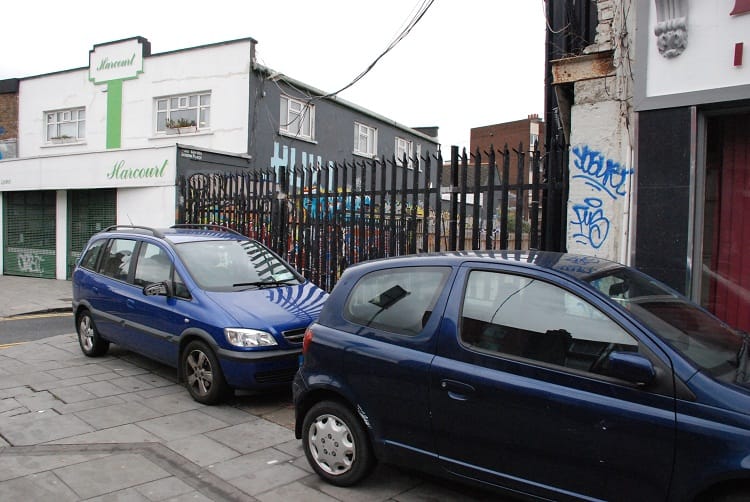What would become of the Civic Offices on Wood Quay if the council relocates?
After The Currency reported the idea of the council moving its HQ, councillors were talking about and thinking through the pros and cons and implications.
There are parking spaces on pavements across the city, but there’s also some debate about whether it’s time to get rid of them.

On a recent Monday morning, on South Richmond Street, three cars sat parked on the footpath leading towards Portobello Bridge.
If you’re in the vicinity often enough, you may have noticed this common practice. Further down, towards The Bernard Shaw pub, another two cars sat on the pavement.
It’s technically not illegal in parts of this stretch, but some would like to see the rules change.
These on-pavement parking spots are known as “private landings” and are a “very common” feature throughout the city, according to a spokesperson from Dublin City Council’s press office.
They’re located outside premises, for residents whose basements extend out under the public footpath. They are, in effect, private property attached to a particular building.
While the footpaths of South Richmond Street may seem wide enough to accommodate both pedestrians and cars, some businesses in the area have raised concerns about parking availability and the abuse of such spaces.
Lily Foran, who runs Picado Mexican food store, says that when she opened it, the space had been vacant for some time. So some people had taken to parking up on the pavement outside.
“We had quite a lot of problems with two different cars, including a taxi, that used to park and block the entrance to the shop,” she says. “We didn’t know who they were. I left quite a few notes and when I rang the council they told me that, because underneath most of the buildings on this street there are basements and it’s considered private property, they can’t clamp.”
On South Richmond Street, it’s hard to gauge whether the cars parked on the footpaths are legitimate private-landing owners, tenants, or chancers.
There are 28 private landings on the street, according to the council. And they’re problematic from an enforcement point of view.
The council has carried out 45 enforcement actions on South Richmond Street in 2016, it’s powerless where private landings are concerned.
“Private landings can only be taken in charge by Dublin City Council by the owner ceding ownership to the council,” said the press office spokesperson.
“This has happened in some areas where a building owner cedes ownership for whatever reason, but generally to avoid having to maintain the private landing themselves.”
But that’s fair, says Fine Gael Councillor Paddy Smyth. “If the person owns the land that’s their business and they can park wherever they like,” he says. “[The council] would have to CPO the land and that can be done for transport reasons.”
It would be costly, though, and perhaps there aren’t enough complaints to justify the move. But some do question how it plays into the council’s efforts to make the city more pedestrian friendly.

The policy is bad for pedestrian infrastructure, says Labour Councillor Andrew Montague, who is also head of the council’s planning committee.
It is unlikely that the council is promoting the practice, he said. It’s more likely that council officials’ hands are tied.
“It’s often very difficult to restrict those rights once they’ve been acquired,” he says. “It would certainly be the policy going forward not to give anybody else the rights, and if any opportunity arose, to remove those rights again. I would say that’s the situation.”
Montague says that cars parked on footpaths can be obstacles for guide dogs. “It should not be a right to park on the footpaths,” he says. “It’s an anomaly that goes against the council’s plans.”
In his antiques shop near the top of South Richmond Street, Christy Bird says many of the buildings existed before parking was a problem. “The houses are older than cars,” he says. “But it’s not ideal, parking up on pavements. It’s a hazard for pedestrians.”
Bird says that, yes, residents must be catered for, but so should businesses in the area. “If you live in an area you can get a [parking] permit, but if you work in an area you can’t,” he says. “There’s nothing [the council] can do though.”
Better parking for businesses would help, says Picado’s Foran.
She says there are business owners who leave their car parked all day in the private landings, presumably with the permission of the landlord or in line with their tenancy agreements.
But no one who works in her building parks outside the front door, she says.
They all, Foran included, rent spaces nearby. “We’re not allowed to get residential parking,” she says. “That’s why I think people end up parking on the paths, because it’s way too expensive.”
Of course, those parked in the private landings are quite possibly legit in doing so.
The broader issue, says Green Party Councillor Ciarán Cuffe, is whether or not we should allow the legal anomaly to endure.
Cuffe has written to the management of Dublin City Council requesting a briefing note from the council’s law agent to see if any action can be taken to prevent property owners or others from parking their cars in front of the area’s buildings.
“Access to these lands is only possible by travelling across the public footpath,” wrote Cuffe. “Such action detracts from the appearance of the lands and the streetscape, and may present a danger to pedestrians.”